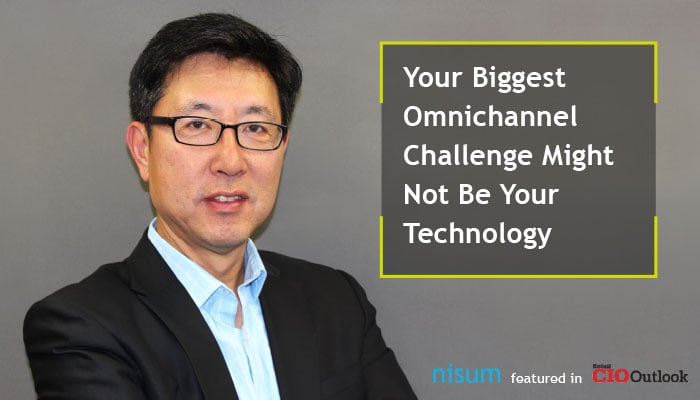"The biggest hurdle retailers face isn’t technology— it’s most often the people behind the technology that support different channels," said Nisum VP of Digital Consulting, Kyu Cho in Retail CIO Outlook. Check out the full article, "Your Biggest Omnichnannel Challenge Might Not be Your Technology" on their website here or read it below.

Your Biggest Omnichannel Challenge Might Not Be Your Technology
Retailers know that omnichannel is the way of the future. Having a digital presence is table stakes at this point, with mobile and social commerce not far behind. Retailers also know that achieving true omnichannel efficiency often presents major challenges around seamlessly integrating backend and frontend systems with multiple channels in order to streamline customer touchpoints. While the goal is clear, that is, customers should have a seamless brand experience as they move between devices and channels, to the path to achieving that goal is often unclear, with different organizations facing their own challenges along the way.
However, as retailers look for the most efficient ways to integrate multiple channels and streamline consumer touchpoints, the biggest hurdle they face in doing so isn’t technology—it’s most often the people behind the technology that support different channels. While the compatibility issues that come with trying to bring a number of disparate and siloed technology systems together has been a hot topic of conversation in the industry, less discussed is the increasingly rampant “people problem” in omnichannel adoption and implementation—and how left unaddressed, this can stop any organization’s digital transformation in its tracks.
There are few culminating factors giving way to the people problem in omnichannel adoption, many of which stem from the traditional organizational architecture under which many retailers operate. That is, retail organizations are often structured by channel, as in, brick-and-mortar, eCommerce, call centers, etc. Each of these channels has its own leadership and performance goals to measure against. Similarly, business and/or technical organizations are designed to either increase the top line (profit center), or do more for less (cost center), yet seldom both. For true omnichannel efficiency, all departments within a company should have accountability and performance measured by their contribution to both revenue and sensible management of their expenses.
This can be difficult to achieve as many companies’ go-to-market strategies and operating models support products and/or brands. However, strategies based on the market segment (age, gender, geography, etc.) should be given a serious thought. The vast majority of companies in the marketplace are organized by function under a specific brand or product line. Most companies have leaders for each functional area CIO, CMO, CFO, CTO, CAO, and so on.
Here’s the catch: consumer purchasing behavior is not segmented that way.
The buying experience is a rapid back and forth evaluation of product characteristics, such as value, design, color, occasion, function, brand, etc. After a product is selected, the buying decision is made by evaluating purchasing options such as online vs. in-store, use of cellphone vs. computer, delivered or picked up, etc. These decision patterns often closely correlate to characteristics such as age group, gender, and geography. Depending on a company’s target customers, they may benefit by mirroring their own customers’ behavior and purchasing patterns.
It’s difficult to drive organizational change on a large scale such as this. Employees at all levels of the organization are used to functioning a certain way, and motivating behavior change is never easy. The challenge for retailers then becomes how to most effectively drive organizational change to support an omnichannel architecture.
Buy in and sign off from the top down is crucial. Retails serious about omnichannel should consider appointing an omnichannel officer that reports directly to the CEO and/or president of the company. Organizations should also adopt a shared services operating model to govern store and eCommerce technologies, while the internal IT team should be viewed as a consulting group to ensure operations are running seamlessly across departments.
Most importantly, operation processes must be centered around customer experience. This, of course, is dependent on a clear view of customer behavior patterns, but only when everyone at every level of the organization is educated around the importance of a seamless customer experience, regardless of channel, will retailers begin to yield the true value of omnichannel technology.



